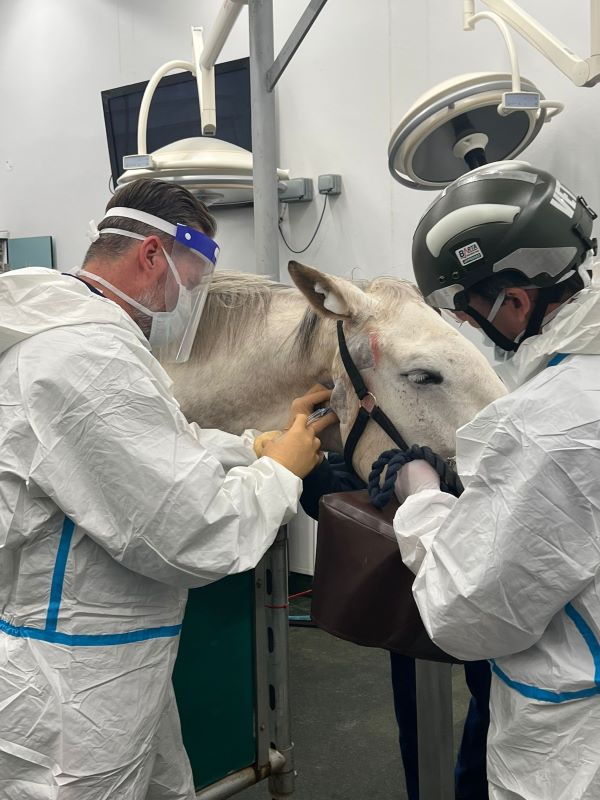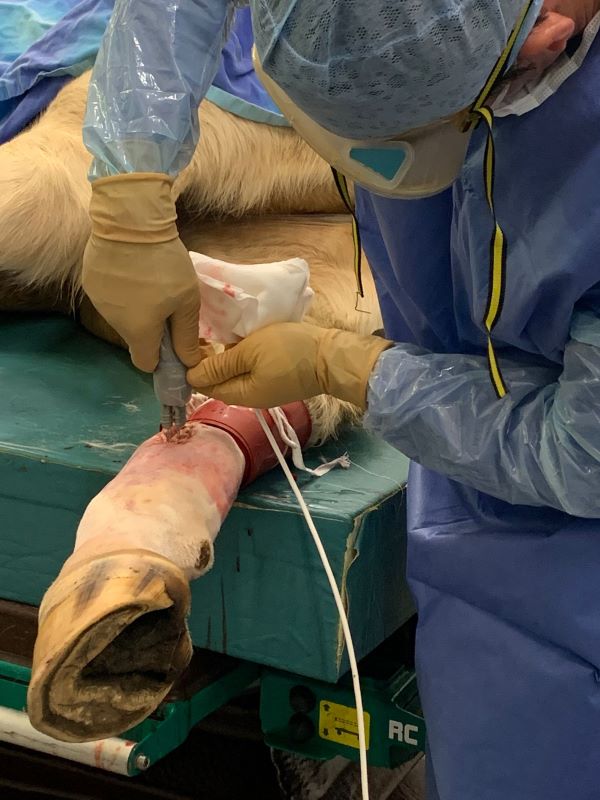24 hour contact: 01707 666297
Tumour Specific Electroporation at RVC Equine
Tumour Specific ElectroporationTM at RVC Equine

What is Tumour Specific Electroporation (TSE)?
This is a new dynamic electroporation technology aimed at treating local tumours that are not easily removed with surgery. It can also be used to help clear away cancer cells that were left behind if initial attempts at surgical removal did not completely cut away all of the tumour cells. It requires the use of a special machine called an electroporator that delivers an electrical current to the tumour via needles that are placed into the tumour. The equipment is supplied by Vetiqure, and was funded by the RVC Animal Care Trust.
What conditions can this be used for?
It is used for treating solid cutaneous tumours in horses and other animals. The RVC Equine Referral Hospital (ERH) is now using TSE for the treatment of equine melanomas and sarcoids. This technology could potentially be used for any solid cutaneous tumour.
Clinical challenges of equine melanoma and sarcoid treatments
Sarcoids and melanomas are common in the UK, with 6-7% of horses affected by sarcoids, and up to 80% of grey horses over the age of 15 affected by melanomas. The ERH is frequently presented with horses with cutaneous tumours which are inoperable due to their location, type or size. Such tumours can be treated with intratumoral chemotherapy (injection of chemotherapeutic drugs directly into the tumour), however the efficacy of the drugs is limited due to poor penetration of drugs into tumour cells.
To enhance uptake of drugs and improve treatment success, the ERH has successfully utilised a method called electrochemotherapy (ECT). This promotes the increased uptake of the drugs through the administration of permeabilizing electric pulses that temporarily open pores in the tumour cells, allowing the chemotherapeutic drugs to diffuse into the cells down a concentration gradient. This increases the cytotoxic effects of the drug and the efficacy of treatment. Application of the electric pulses creates a vascular lock within the tumour which helps prolong drug exposure time.
The main disadvantage of conventional ECT is that it requires general anaesthesia. As the amplitude (peak voltage) of the electrical pulses cannot be adjusted, there is a risk of irreversible electroporation which results in direct cell death and necrosis. This is known as ablative electroporation, and leads to substantial tissue necrosis. The use of surface electrodes significantly limits the depth of tissue that can be electroporated.
How does TSE differ from traditional treatments?
Tumour specific electroporation (TSE) is a patented technology that has the potential to circumvent the limitations of ECT. The unit gradually decreases the amplitude of the electric pulses based on the electrical resistance in the tumour tissue. The dynamic pulse prevents irreversible electroporation. This spares healthy tissue and stimulates tumour cell apoptosis (a process of process of programmed cell death) and an immune response rather than causing direct cell death and necrosis. Due to the reduction in peak voltage, the treatment can potentially be delivered in standing conscious patients. An additional advantage of TSE is that the electric pulse is multidirectional and utilises needle electrodes which can penetrate tumour tissue. This minimises the risk of missing areas during treatment and allows treatment of tumours up to 2cm in depth.

Research evidence - TSE applications for equine cases
TSE treatment has undergone clinical trials here at the RVC since December 2022.
Initial results indicate that this innovative treatment modality has the potential to significantly improve the welfare of horses with tumours that are not amenable to surgical excision.
There are currently no published reports documenting the use of TSE in horses and the RVC Equine team are collating further evidence for future evidence-based research results
TSE effectiveness for equine cases?
TSE appears to be extremely effective for treatment of sarcoids, with most horses being tumour free after treatment.
The technology is less effective against melanoma. Although it is unlikely to result in tumour remission, the treatment does result in significant tumour shrinkage. This improves welfare and prevents functional problems associated with these tumours in areas of the body where tumour resection is not possible. Long term outcomes have not yet been documented, but it is possible that further tumour shrinkage may be possible over time due to stimulation of an immune response against the tumour.
RVC TSE services
TSE treatments are available for RVC Equine referral cases from September 2023 onwards
What is the process for TSE treatment at RVC Equine?
Typically, TSE Equine cases will be seen within two weeks from a case referral being accepted
Once the client brings the patient to RVC Equine Hospital, the patient will
- Be admitted as an in-patient
- Be clinically assessed and an appropriate treatment plan will be made. This might involve TSE by itself, or in combination for surgical removal of tumours where possible.
- Be prepared for standing sedation or general anaesthetic (whichever is deemed clinically most appropriate)
- The procedure takes approximately 1 hour
- The patient will be kept under observation overnight and normally will be ready for collection the following day. If TSE is combined with surgical removal of other tumours, hospitalisation may be extended for up to 5 days.
How does TSE improve the outcomes for patients and owners?
- potentially reduces the need for general anaesthetic and the subsequent risks that entails
- minimises damage to surrounding tissue
- reduces hospital inpatient time
- results in faster recovery times
These factors along with strong clinical outcomes illustrate the important role TSE plays in the treatment of both large equine melanomas and sarcoids.

